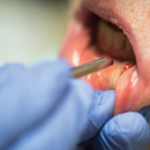NEW YORK (Reuters Health)—Ultrasonography of the major salivary glands may have a role in the diagnostic evaluation of patients with clinically suspected primary Sjogren’s syndrome, researchers from the Netherlands report.
Salivary gland biopsies and anti-SSA/Ro antibodies are important for classifying patients as primary Sjogren’s syndrome (pSS). Some studies have also supported using ultrasonography of the major salivary glands as a diagnostic method.
Dr. Hendrika Bootsma from University Medical Center in Groningen and colleagues in the EULAR US-pSS Study Group assessed the validity of salivary gland ultrasonography compared with parotid and labial gland biopsies, sialometry, and anti-SSA/Ro antibody status and various classification criteria in their cross-sectional study of 103 patients with clinically suspected pSS.
Salivary gland ultrasonography predicted parotid gland biopsy outcomes with 84.9% accuracy and an optimal cutoff ultrasound score of 15 (of a possible 48 points) and labial gland biopsy outcomes with 82.4% accuracy and an optimal cutoff score of 14, the team reports in Annals of the Rheumatic Diseases, online July 28.
Salivary gland ultrasonography also predicted anti-SSA/Ro antibody status well, with 80.3% accuracy. In contrast, it was a poor predictor of sialometry outcomes, with only 69.6% accuracy.
Ultrasonography proved to be accurate at predicting pSS classifications according to American European Consensus Group (AECG), American College of Rheumatology (ACR), and ACR-European League Against Rheumatism (EULAR) classification criteria.
Among patients with positive salivary gland ultrasonography findings combined with anti-SSA/Ro antibodies, 78% had a positive parotid gland biopsy and 94% had a positive labial gland biopsy; 94% or more of these patients met classification criteria for pSS.
Similarly, most patients with negative ultrasonography findings and absence of anti-SSA/Ro antibodies had negative parotid gland biopsies (93%) and negative labial gland biopsies (77%) – and did not fulfill pSS criteria.
The authors offer two conclusions. First, they write, “Positive salivary gland ultrasonography (sUS) predicts classification according to the AECG, ACR, and ACR-EULAR classification criteria, but negative sUS does not exclude classification.”
Second, “Positive sUS in combination with presence of anti-SSA/Ro antibodies highly predicts classification according to the AECG, ACR and ACR-EULAR criteria. The combination of negative sUS and absence of anti-SSA/Ro antibodies highly excludes classification when parotid gland biopsy outcome is considered as an item for classification, but when the outcome of labial gland biopsy is considered as a criteria item, combining negative sUS with absence of anti-SSA/Ro antibodies does not exclude classification.”
Dr. Bootsma did not respond to a request for comment.

